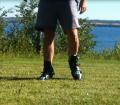Results 1 to 9 of 9
Thread: Feasibility of recreating this.
-
10-06-2015, 06:58 AM #1Student

- Join Date
- Oct 2015
- Posts
- 3
Feasibility of recreating this.
Hi everyone.
I would like to try and recreate the below daytime running light mirrored to fit each side of the car as I've damaged mine.
Do you think it would be possible?
I was going to try and make a model of two parts a clear lens and a chrome painted lower structure to house the led's and fix it to the car.

-
10-06-2015, 07:16 AM #2
The lens can't be 3D printed due to laws that regulate all light emissions from vehicles.
-
10-06-2015, 07:25 AM #3Student

- Join Date
- Oct 2015
- Posts
- 3
Would it be possible minus the lens? Or for off road applications?
-
10-06-2015, 08:14 AM #4
Possible? Yes. Worthwhile? Difficult to say. Printed parts don't have the same structural integrity of injection moulded parts (only up to 60%, apparently) so your part may break under stress, particularly for offroad.
Size is a limiting factor too. You don't say how big this is but printing something this large in, say, ABS or PA may be very difficult without the right printer and know-how. Don't even bother making this in PLA.
-
10-06-2015, 11:31 AM #5
well I'd use pla. Print it right and it's stronger than injection moulded parts.
The main reason for not printing the lens is that you simply cannot print optically clear items with fff.
Certain sla resins will do it, sure.
But that means using a print service and I suspect you'll find it's a lot cheaper to buy one on ebay than to get it printed by a print service.
The grey/silver part - yeah not a problem - IF you can create the cad model for it :-)
-
10-07-2015, 01:03 AM #6Student

- Join Date
- Oct 2015
- Posts
- 3
The oem lights are nearly $700 each so $1400 for the pair. How much do you think it would be to get it printed?
-
10-07-2015, 05:23 AM #7
Source?
3D printed parts are never as strong as injection moulded parts. Never. IM parts are solid while 3D printed parts are easily delaminated. This is one of the drawbacks of the technology.
Furthermore PLA is completely unsuitable. It is harder, not stronger than ABS. This 'hardness' makes it brittle and less shock resistant. It also has a glass point of around 60 - 65 degrees so using it in an environment that is exposed to high temperatures is going to result in part failure.
Getting back to the OP: Can you print it? Yes, if you had that right equipment. But it may cost you anywhere from half to three quarters of the price of an original, then there are hours of hand-work to get it all to fit. And ultimately you just won't get longevity out of it. Plus there's the safety factor. Do you really want to print (and possibly have fail) a part that's this important? Just saying.
-
10-07-2015, 07:40 AM #8
pla is NOT more brittle - you're just not buying the right pla and you're still going with material specs from the first pla filament..
And parts printed with mesh infill are considerably less brittle than solid parts - the mesh massively reduces shockwave transmission, so parts don't shatter. And printed right they certainly won't delaminate.
The mesh infill also gives flexibility and lightness without compromising on strength.
Print it right and a 3d printed part is lighter, stronger and more flexible than an injection moulded part. It's one of the advantages of 3d printing over injection moulding.
Heat can be a factor - but generally only if you live in somewhere like arizona - or south africa :-)
-
10-10-2015, 06:17 PM #9
Designing something like this to fit like the original, unless it was for multiple end users, would already be financially inadvisable, if you consider time to be money. If you were creating a custom part for a restoration project for example, then its a different story altogether.
Yes it can be done, but I don't believe the time put in to make sure it works like the original would be worth it.
Regarding the pla discussion; I think you both have valid points, but Pla is most definitely not suitable for this kind of job. As a prototype fit test, yes. End use, no way. It deforms in outdoor sun temperatures, and I have tested this in Canadian environment.
If you are talking about pla + or other pla brands that have additives that modify the temperature range melting points/glass transition temperatures and flexibility modulus, then you aren't really talking about pla. Even then, compared to abs, they are not a good source for a car part exposed to 24/7 environment wear and tear. For this, a good hard nylon filament might work. But fit and finish without warping would still be an issue.
PLA is a great material, don't get me wrong. Easy and reliable to print. Love it. I mean, my first working prototype is made from PLA, and it withstood initial testing without shattering or laminating, for a good while at least.
My two cents.




 Reply With Quote
Reply With Quote








Extruder not feeding during print,...
Yesterday, 01:59 AM in Tips, Tricks and Tech Help